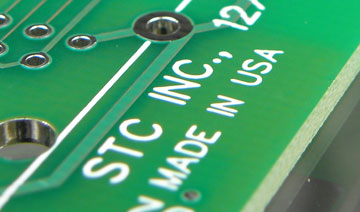
Trends in US Manufacturing
For the past number of years, the topic of “re-shoring” has been addressed in various manufacturing-industry publications, as well as in the general media. Re-shoring is the term used to describe companies moving segments of production or services back to the United States after having previously moved that work to off-shore locations.
However, in practice, moves to US manufacturing have primarily been the result of specific scenarios, according to STC President Brad Cross.
“There are specific situations where we have a distinct competitive edge, for example with government projects that require a certain percentage of the assemblies to be manufactured in the US,” says Cross. “But in addition to those types of projects, we also have an edge when companies must deal with defective parts that have entered their supply chain”

In these cases, component defects aren’t discovered until they’ve reached US plants. And by that time, the defective parts are already installed in assembled products, and additional defective parts are likely sitting in multiple shipping containers in various stages of the supply chain.
“When these kinds of problems arise, we often beat the overall costs that result from these types of overseas manufacturing problems,” Cross says. “While STC regularly outperforms other manufacturers in quality and lead time, these common types of situations give us yet another advantage.”
Another issue that drives re-shoring is source traceability, which has become a much bigger area of interest since the Dodd-Frank bill was signed in 2010. To address the humanitarian crisis in Central Africa, Section 1502 of this law requires that companies disclose whether any minerals used in their manufacturing (such as tin, tungsten, and gold) originate from the Democratic Republic of the Congo or any adjoining countries.
Angie Calkin, who serves at the STC Quality Manager, says this requirement gives US companies like STC an edge where source traceability is a concern.
“In order to be compliant with this law, we must carefully select and monitor US vendors who have already verified their own sources, and that’s an advantage for a company like ours since we have longstanding relationships with so many of our vendors.” Calkin says. “For overseas manufacturers, source traceability is rarely a requirement so when US companies try to require it of their suppliers, it becomes another layer of complexity that is almost impossible to get through.”
According to Cross, being familiar with your product sources reduces reliability issues that can result from another large area of concern, which is component counterfeiting.
“Component counterfeiting is something that has gone on for many years and seems to have increased during the last 20 years, and the key problem with counterfeiting is reliability,” Cross says.
Counterfeit components look identical to the name-brand models they copy, with fake date codes, product markings, and even stamped copies of the brand logo.
Statistics provided by the US Customs and Border Protection agency indicate that China/Hong Kong is by far the largest source of counterfeit goods that arrive in the United States, followed by India, Singapore, and a number of other countries. (https://www.cbp.gov/trade/priority-issues/ipr/statistics)
“It’s costly to test for these inferior components because the testing is time consuming and the tests are often destructive,” Cross added.
“For example, the use of inferior insulation or construction techniques in magnetics drastically reduce a transformer lifespan. Years ago, one of our customers found a Chinese source that was able to provide similar high-voltage transformers at about half our cost, so they began buying the import transformers. The resulting assembled products passed factory testing but ended up consistently failing in customer use far short of their warranties. We resumed supplying their transformers not long after that.”
Cross also claims the counterfeiting problem is even more prevalent in the electronics-component market, though the resulting issues are very similar.
“Semiconductors that would otherwise be expected to last for 20 years also pass testing after installation on the assembled product, but then often fail within a few months, leading to considerable warranty costs for the brand manufacturer.”

